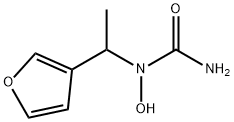123606-23-5
 123606-23-5 結構式
123606-23-5 結構式
基本信息
化合物 T10208
N-1-(fur-3-ylethyl)-N-hydroxyurea
N-[1-(3-Furanyl)ethyl]-N-hydroxyurea
Urea, N-[1-(3-furanyl)ethyl]-N-hydroxy-
常見問題列表
|
5-LO
|
LTB4 1 μM (IC 50 ) |
A-69412 inhibits the formation of 5-HETE by the 20000×g supernatant of RBL-I cells in a dose-dependent fashion. The shift to greater potency at lower substrate concentrations is consistent with A-69412 being a competitive inhibitor of the enzyme. A-69412 also inhibits the formation of LTB 4 in calcium ionophore A23187 stimulated human PMNL (IC 50 =8.9 μM). A-69412 is more potent in inhibiting LTB 4 formation in ionophore-stimulated human whole blood. The potency of A-69412 in a number of assays using several donors consistently show activity in the low micromolar range (mean IC 50 =1.4 μM, range 0.5-3 μM, 9 donors), several fold more potent than its activity in the other in vitro assays.
Oral doses of A-69412 are found to inhibit leukotriene production in a number of species. For example, A-69412 is found to be a potent long-acting inhibitor of leukotriene formation in vivo in the rat (oral ED 50 =5 mg/kg). A-69412 is remarkably potent in the dog, giving nearly complete inhibition through 16 h after a single 5 mg/kg dose. Plasma concentrations in the dog studies are 38 μM at 0.5 h after dosing and 5 μM at 16 h. These data are consistent with the 100% inhibition seen ex vivo at 0.5 h post-dosing and the 90% inhibition seen at 16 h. As would be expected from the pharmacokinetic results, A-69412 is clearly superior to zileuton in the cynomolgus monkey. A-69412 gave >50% inhibition of ex vivo LTB 4 biosynthesis in the monkey for 8 h, while zileuton is effective only in the first 2 h after oral dosing. An anaphylactic reaction in the rat peritoneal cavity of passively sensitized animals produces large amounts of sulfidopeptide leukotrienes. Given as an oral solution, A-69412 dose-dependently inhibits leukotriene production in the peritoneal cavity of the rat. In one of the experiments, blood levels of A-69412 are measured. These values range from 4 to 100 μM with doses ranging from 2 to 50 mg/kg. A-69412 also significantly inhibits the reaction if dosed (10 mg/kg) at times up to 8 h before challenge. Plasma concentrations of A-69412 are measured in the time course studies and are found to range from 44 μM at 0.5 h to 10 μM at 8 h after dosing.